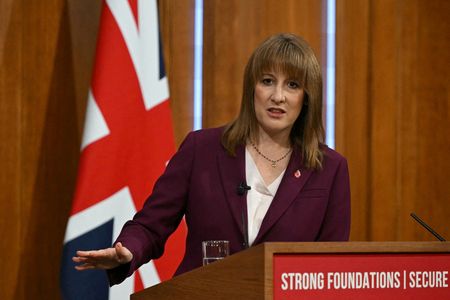By William Schomberg
LONDON (Reuters) -Britain’s borrowing in the first seven months of the financial year was the highest on record except during the COVID pandemic, according to data that lays bare the scale of the challenge facing finance minister Rachel Reeves in her budget next week.
Government borrowing between April and October totalled 116.8 billion pounds ($152.9 billion), the Office for National Statistics said, about 10 billion pounds more than forecast by Britain’s budget watchdog earlier this year.
It was the highest borrowing since the same period in 2020, during the height of the coronavirus pandemic, based on records going back to 1993.
OCTOBER BORROWING EXCEEDS FORECASTS
In October alone, the government borrowed a bigger-than-expected 17.4 billion pounds, the ONS said.
The government’s forecasters at the Office for Budget Responsibility had pencilled in an overshoot of 14.4 billion pounds for October. A Reuters poll of economists showed a median forecast of a 15 billion pound deficit.
Reeves is widely expected to raise taxes in her budget on Wednesday as she tries to reassure investors that she remains on course to meet her fiscal targets.
She wants to stop borrowing to fund day-to-day spending by the end of the decade. However, Friday’s data showed the so-called current budget was almost 84 billion pounds in deficit in the April-to-October period, 10% higher than a year earlier.
STUBBORNLY HIGH COSTS OF SERVICING DEBT
Nick Ridpath, an economist at the Institute for Fiscal Studies, a think tank, said the figures could yet be revised.
“Today’s release does, nonetheless, highlight important context for next week’s budget: uncertainty around tax revenues, pressures on public spending, and stubbornly high costs of servicing government debt,” Ridpath said.
Government receipts – boosted by a big increase to social security contributions in Reeves’ first budget last year – rose by less than the increase in expenditure.
One of Reeves’ deputy ministers said Britain was set to deliver the largest reduction in its primary budget deficit – which excludes debt payments – among the Group of 20 economies over the next five years to get borrowing costs down.
“At the budget next week, the chancellor will set out how we will take the fair choices to deliver on the public’s priorities to cut NHS (National Health Service) waiting lists, cut debt and cut the cost of living,” Chief Secretary to the Treasury James Murray said.
Worries about the scale of tax increases in the November 26 budget have weighed on households and businesses.
Separate data from the ONS published on Friday showed a big drop in consumer spending last month.
The ONS said it had revised down government borrowing in the first six months of the financial year by a relatively small 400 million pounds.
($1 = 0.7639 pounds)
(Writing by William Schomberg; Editing by Kate Holton and Conor Humphries)











